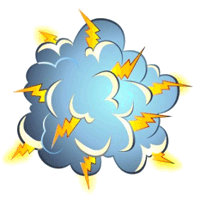Let’s imagine a man called Peter leaving the gym and running to his car with his duffel bag over his head to protect himself from the rain. When he reaches the car and is about to open the door, he stops because he sees Laura, his best friend’s girlfriend, kissing another man on the opposite sidewalk. The girl is wearing a pair of sunglasses, but all the same, he recognizes her.

Peter stands in the rain for a while as he watches the scene in disbelief. The couple enters a café, so he gets into his car but does not start it. He just sits there with his mobile phone in his hand. The screen displays the name and picture of his friend next to the call icon. More than once, Peter almost dials, but he finally decides not to.
Eventually, regardless of the rain, he returns the phone to his bag, gets out of the car, crosses the street, and enters the café. Laura is sitting at a table, chatting away with her companion. Peter approaches them and sits in front of the girl. Looking at him from behind the sunglasses she has not yet removed, she asks, “What are you doing here?” Peter ignores the question, sneers at her, and says, “Would you call this a little mistake too, or is it just me?”
All right, then! Let’s see how to introduce conflict in this story:
1. Use as many as you can.
In a good story, conflict is everywhere. In addition to the main conflict, you can add peripheral conflicts to create subplots, internal struggles within each character, etc. In the previous example, the first conflict arises when Peter sees his friend’s girlfriend with another guy. This poses a problem for the character because he has to decide whether or not to tell his friend what he has seen. At the end of the scene, a new conflict is presented because in the past, Laura had cheated on her boyfriend with Peter himself. This circumstance adds to the internal debate of the main character whose actions could somehow be influenced by jealousy. As you can see, the more conflicts we play with, the juicier the story gets.
2. Use action.
The motto a writer should always keep in mind is, “If you can show, don’t tell.” This also applies to conflict. Everything that can be shown through facts and action will translate into a more intense experience for the reader.
Looking back at the example when Peter is sitting inside the car, I might have explained that “Peter was fighting an inner struggle between calling his friend and telling him what was happening or directly confronting Laura.” However, I chose to depict Peter sitting inside his car and looking at the phone with his friend’s number displayed on the screen. This way the action itself tells readers what’s going on inside the character’s head.
3. Use dialogues.
Nothing is more boring than two people in meaningless conversation. When you use dialogue in a story, do it with purpose. Dialogue can be used to provide information, introduce the characters to the reader, develop the plot, and of course, to insert conflicts.
In the dialogue that appears in the sample text, Laura doesn’t greet Peter, but curtly asks: “What are you doing here?” These words denote feelings of hostility that may be as much due to their prior relationship as it is to the fact of being caught with another man. Peter’s answer reveals that he and Laura were together in the past and suggests that he also bears some resentment against her.
4. Use external elements.
They can help you increase the power of conflict. For example, the heavy rain Peter is hiding from in the beginning of the story becomes a minor inconvenience when he sees Laura. This way, the importance of the latter event is emphasized.
5. Use symbols.
A wound, color, or specific setting highlights ideas or conflicts. A character’s external scars are often related to internal marks or an inner conflict. In the example, Laura’s sunglasses could be interpreted as a symbol because they act as a mask she wears to avoid being discovered.
6. Use flashbacks.
Sometimes, there is no other choice than to show a scene from the past in order to explain a conflict. In the story about Peter, I haven’t used any flashbacks, so let’s just consider the film “Casablanca” The relationship between the characters is complicated, but the spectator does not understand the real dimensions of their problem until a flashback of what happened between them years ago is projected.
7. The sooner, the better.
Don’t be late in introducing conflict in your story. In the sample text, it appears in the second sentence. If I had taken my time to explain how Peter leaves the gym, greets an acquaintance, stops to watch the rain, or regrets not having taken an umbrella, I would have lost the attention of many readers.
8. Finish what you started.
Every conflict must have an introduction, a development, a climax, and a conclusion. Readers often keep on reading because they want to know how a conflict is going to be resolved. Thus, don’t leave that question unanswered, or they will be disappointed.
Related posts:
No Conflict, No Story
How to Write a Short Story
How to Present your Characters
 This site uses cookies. By continuing to browse the site, you are agreeing to
This site uses cookies. By continuing to browse the site, you are agreeing to 



There are no comments in this entry. Go ahead and leave yours!